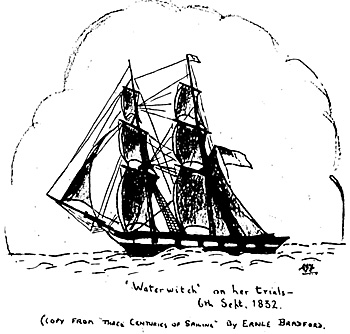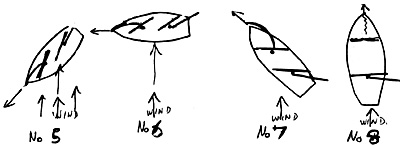 I have been reading your book "Naval War Games". and came across something in the
movement rules that I could not accept and felt I must write to you about. Sr this has had to wait until I had the time to write.
I have been reading your book "Naval War Games". and came across something in the
movement rules that I could not accept and felt I must write to you about. Sr this has had to wait until I had the time to write.
On page 88 of "Naval War Games", you quote the rules of one Gerard de.Gre, Lieut. USNR (Ret). Can he really have served in the US navy always in power vessels? His rules state:
- 5. Ships may not sail directly into the wind. Mobility factor X O" (agreed).
6. When beating into the wind, that is when the wind is coming into the ship at approximately 45 degrees of the bow, the mobility factor is X 1" (in other words, slow).
7.When reaching into the wind, that is when the wind is coming in at 90 degrees perpendicular to the beam, the mobility factor is X 2" (speed medium).
8. When on the broad reach or sailing directly before the wind, that is, when the wind is directly behind the ship or at 45 degrees of the stern, the mobility factor is X 3" (speed fast).
On page 90, Mr. A. Saunders is quoted as saying:
- "Let us suppose that the ship is sailing with the wind aft. the fastest sailing position
of all."
Elsewhere in the book the same misconception is perpetuated. Anyone who has done any sailing at all will tell you that in fact beating is the fastest sailing position, reach the next fastest, broad reaching next, and running before the wind is the slowest (and most uncomfortable). To the 'landlubber' it may seem logical that the more you try to sail towards the wind which is your propellant, the slower you must go, as the wind must tend to blow you backwards. If the ship had no grip in the water this would be so (e.g. a flat bottomed craft). For the explanation of this, consider what forces influence the movement of the ship. Ignore tidal set (for all your rules quoted do so), and it is wind strength and sail area. Without any grip on the water, given by draught (depth of hull below water) and keel or adjustable drop keel in shallow draught vessels, she could not sail in any direction except directly before the wind, or very slightly to right or left of it, as the wind would simply blow the whole ship over the surface of the water.
 Sketch No. 1 is looking down wind on a ship beating, No.2 is reaching, No- 3 is broad reaching and No.4 is running. Notice the area of canvas that is visible to the wind, and how much is shielded. In sketch No.4 only the sails on the main mast receive the full force of the wind, and the topsail on the main mast gets some - the rest of the sails will feel virtually none of the wind force, so the propellant force is only about one-third or less.
Sketch No. 1 is looking down wind on a ship beating, No.2 is reaching, No- 3 is broad reaching and No.4 is running. Notice the area of canvas that is visible to the wind, and how much is shielded. In sketch No.4 only the sails on the main mast receive the full force of the wind, and the topsail on the main mast gets some - the rest of the sails will feel virtually none of the wind force, so the propellant force is only about one-third or less.
Now consider the strength of wind, and the penomenon that sailors call the "apparent wind". Consider these four sketches:
Sketch No. 5 is again beating, No. 6 reaching, No. 7 broad reaching and No. 8 running. No. 5 shows that the ship is moving towards the wind, and so the speed of the ship is added to that of the wind. Suppose that the wind speed is 10 knots, and he ship speed is 10 knots (your figure for a frigate). This means that the apparent wind on the sails is about 18 knots, thus making the ship move a little faster yet about 14 knots). In No. 6 the ship moves across the wind, neither increasing nor decreasing the wind pressure (10 knts).
 In sketch No. 7 all sails are filled, but the hip is moving away
from the wind, and so reduces the wind pressure on the sails, say about 5
mph, and thus the apparent wind is reduced to only 5 knots. Thus the vessel
must slow down. This of course increases the wind pressure, and the vessel
will gain little speed, approximately 7 knots speed. Sketch No. 8 shows the
ship moving away from the wind, only the nails on the main mast receive any
wind, thus reducing the speed by half. This is directly away from the wind
which reduces the apparent wind further - speed only about 4 knots. And
this is without any allowance for tidal stream. Thus you get speeds as
follow at No. 5 = 15 knots. No. 6 = 10 knots. No. 7 knots. No. 8 = 4 knots.
In sketch No. 7 all sails are filled, but the hip is moving away
from the wind, and so reduces the wind pressure on the sails, say about 5
mph, and thus the apparent wind is reduced to only 5 knots. Thus the vessel
must slow down. This of course increases the wind pressure, and the vessel
will gain little speed, approximately 7 knots speed. Sketch No. 8 shows the
ship moving away from the wind, only the nails on the main mast receive any
wind, thus reducing the speed by half. This is directly away from the wind
which reduces the apparent wind further - speed only about 4 knots. And
this is without any allowance for tidal stream. Thus you get speeds as
follow at No. 5 = 15 knots. No. 6 = 10 knots. No. 7 knots. No. 8 = 4 knots.
To show that the square riggers could and did turn their yards nearly into line with the centre-line of the ship, I have copied a picture of the Brig Waterwitch, on trials in 1832, from 'Three Centuries of Sailing' by Ernle Bradford (borrowed from the ublic Library).
I could not let this subject pass, particularly as you emphasise that wargamers strive to reproduce all situations realistically. You are at Southampton - go down to any Sailing Club on the Solent and I am sure that anyone will be glad to take you out and demonstrate the different points of sailing -- in a fresh breeze you will really see and feel the difference.
Back to Table of Contents -- Wargamer's Newsletter # 105
To Wargamer's Newsletter List of Issues
To MagWeb Master Magazine List
© Copyright 1970 by Donald Featherstone.
This article appears in MagWeb.com (Magazine Web) on the Internet World Wide Web.
Other articles from military history and related magazines are available at http://www.magweb.com